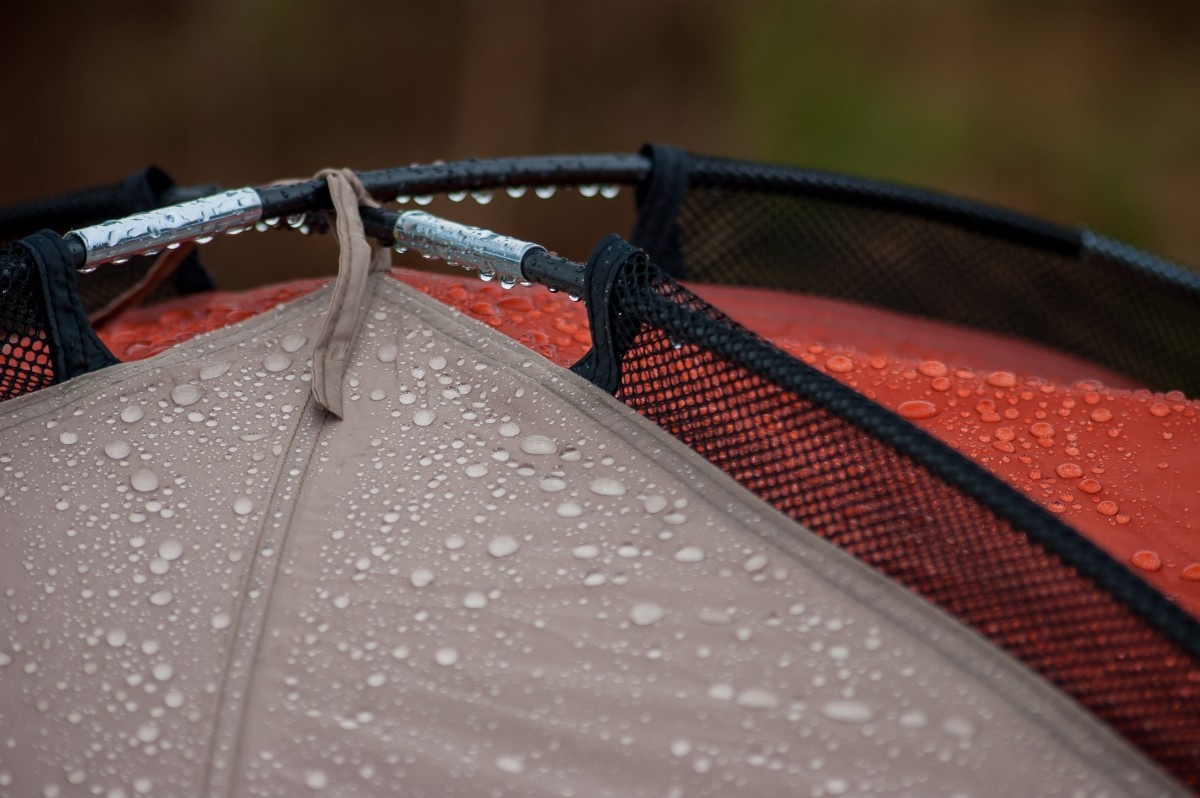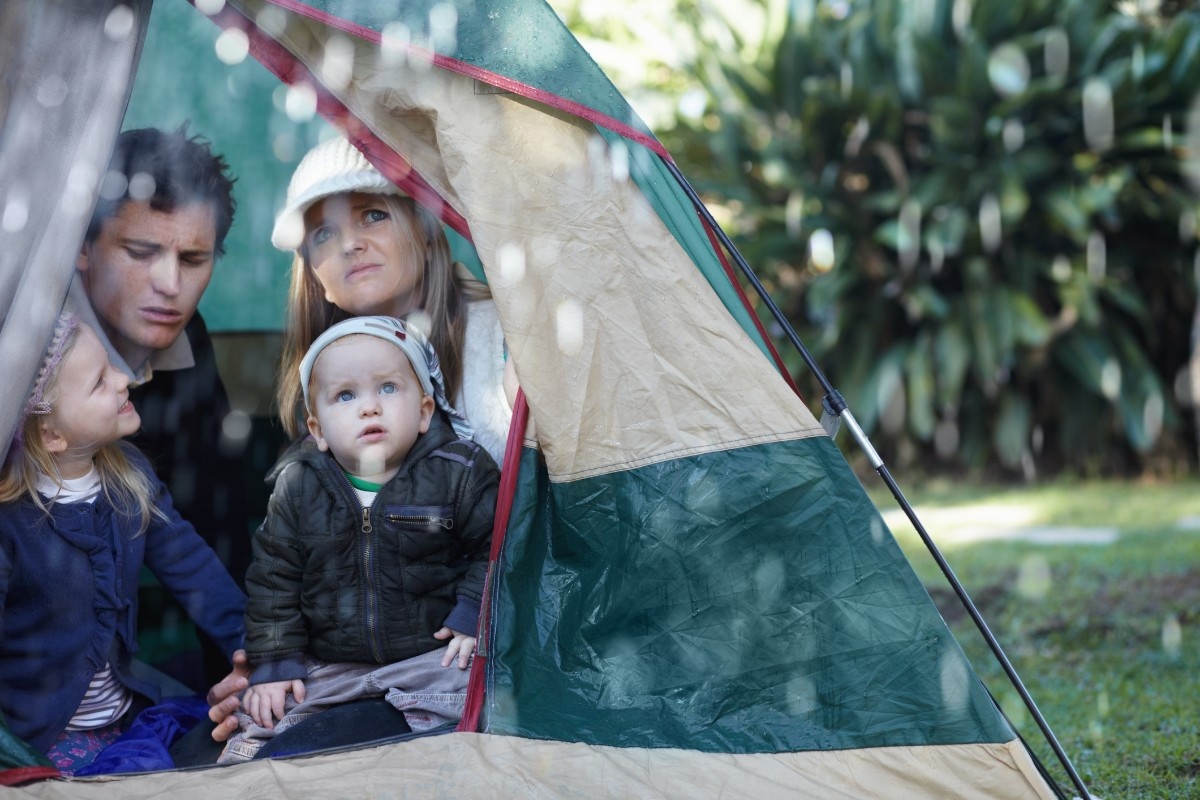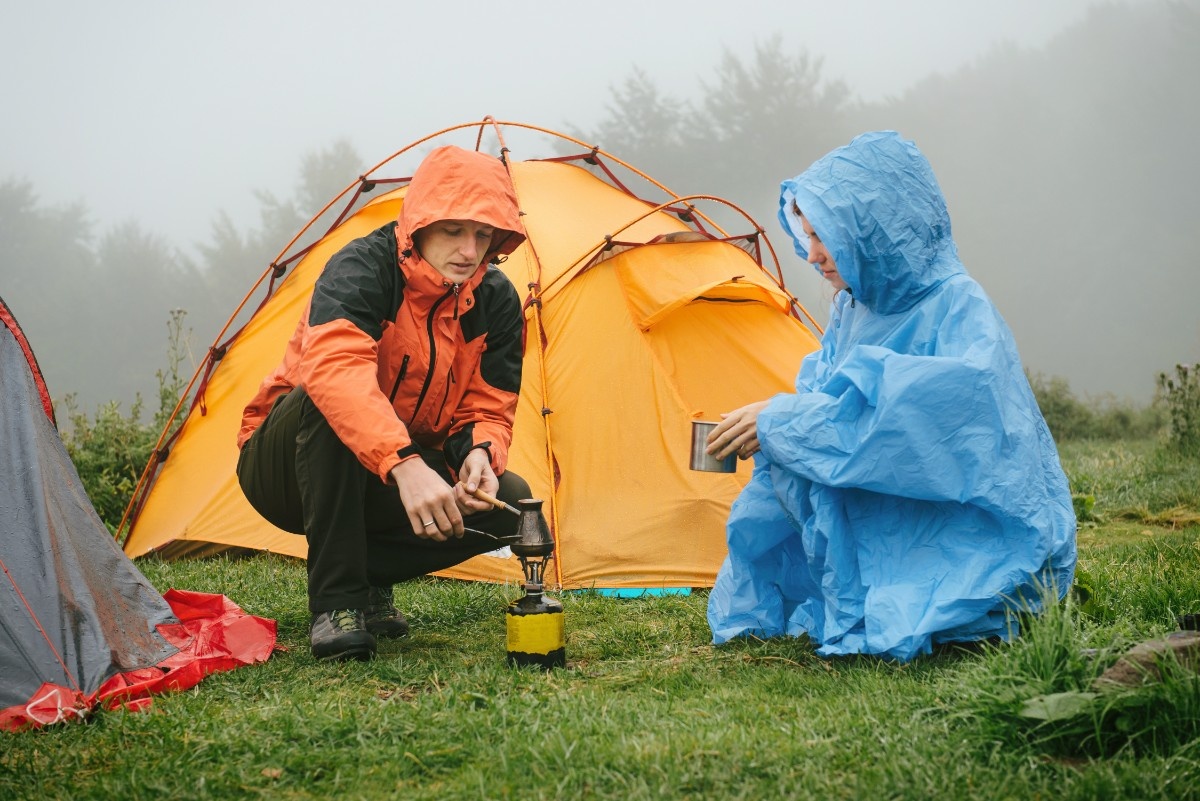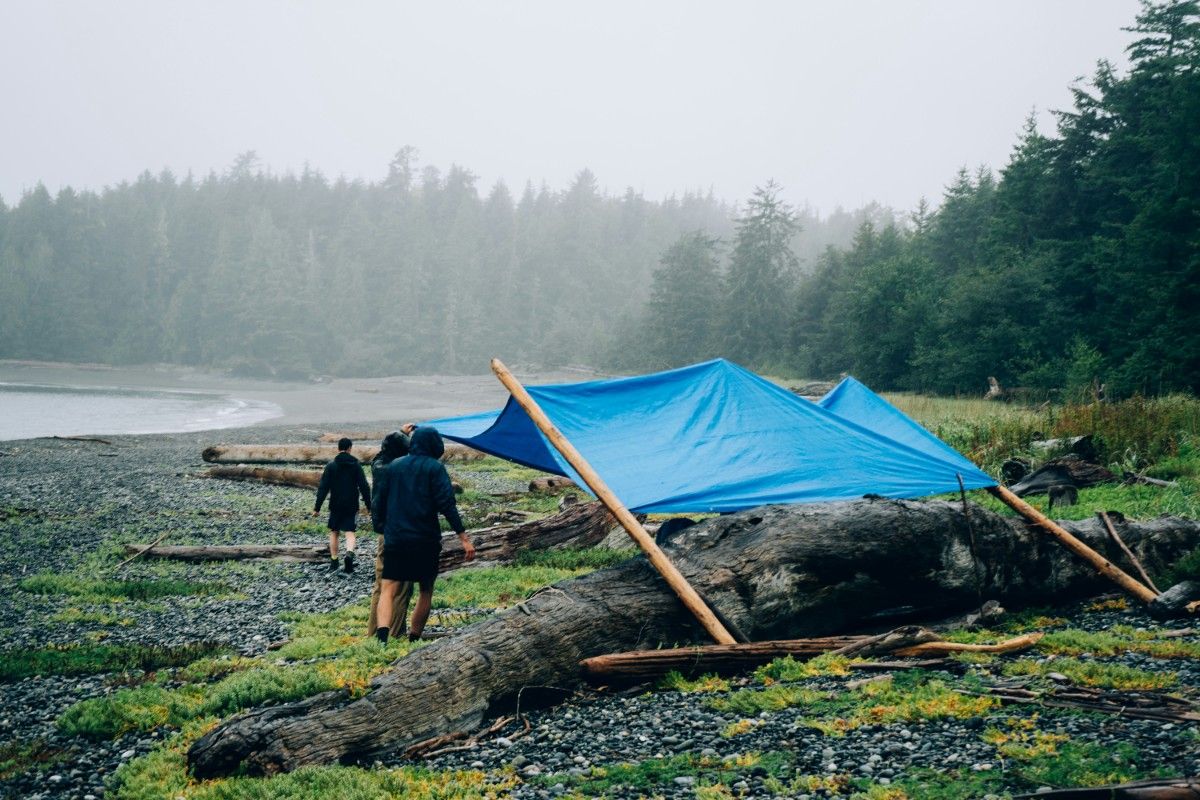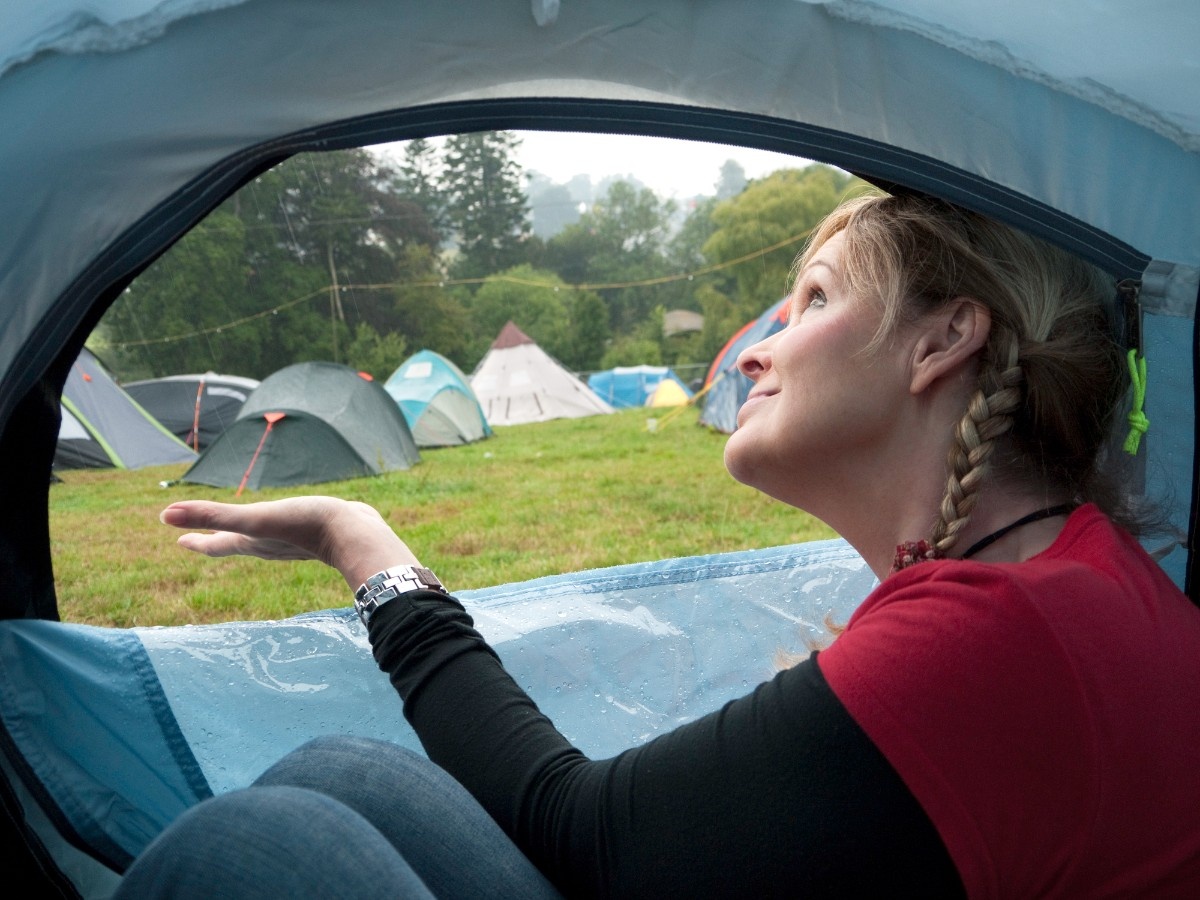Essential Gear for Rain Camping
Waterproof Shelter Solutions
When it comes to camping in the rain, your primary defence against the elements is your shelter. A high-quality, waterproof tent is absolutely essential. Look for tents with a hydrostatic head rating of at least 2000mm, which indicates excellent water resistance. For couples or solo adventurers, a 2 man waterproof tent is often sufficient, while families or groups might opt for a 4 man waterproof tent to ensure ample space.
However, even the best tents can benefit from additional protection. This is where tent waterproofing comes into play. Tent waterproofing spray is a fantastic way to enhance your tent's ability to repel water. Before your trip, clean your tent thoroughly and apply a spray on waterproofing for tents evenly across the entire surface. Pay special attention to seams and high-wear areas, as these are often the first places where water might penetrate.
In addition to your tent, consider bringing a tarp or camping rain shelter. These versatile items can be set up in various configurations to create additional covered space at your campsite. You can use them to establish a dry area for cooking, socialising, or storing gear. When choosing a tarp, opt for a lightweight, durable material with reinforced corners and multiple tie-down points for maximum flexibility.
Remember, your shelter isn't just about keeping rain out – it's also about managing condensation inside. Look for tents with good ventilation features, such as mesh panels or adjustable vents. This will help reduce internal moisture buildup, keeping you more comfortable throughout your stay.
Rainy Weather Clothing and Footwear
Proper clothing is crucial when camping when raining. Start with a good quality, breathable waterproof jacket and trousers. Look for items made with materials like Gore-Tex, which will keep you dry without causing you to overheat. Remember, staying dry isn't just about keeping rain out – it's also about managing sweat and internal moisture.
Layering is key when dressing for rainy weather camping. Start with a base layer made of synthetic materials or wool, which wick moisture away from your skin. Avoid cotton, as it retains moisture and can leave you feeling cold and clammy. Over your base layer, wear an insulating mid-layer, such as a fleece jumper. Your waterproof jacket and trousers form the outer layer.
Don't forget about your extremities. Waterproof gloves and a hat can make a significant difference to your comfort levels. For your feet, waterproof hiking boots are essential. Make sure they're well broken in before your trip to avoid blisters. Pack plenty of spare socks – dry feet can be a game-changer when camping while raining.
Consider bringing gaiters as well. These waterproof coverings fit over your boots and lower legs, providing an extra layer of protection against rain and mud. They're particularly useful when hiking through wet undergrowth.
Camping Furniture and Accessories for Rainy Conditions
When rain and camping go hand in hand, having the right furniture can greatly enhance your comfort. A camping chair with rain cover is an excellent investment. These chairs come with a built-in canopy that protects you from light rain, allowing you to sit outside comfortably even during a drizzle. They're perfect for reading, enjoying a hot drink, or simply watching the rain fall around you.
In addition to seating, consider bringing a portable camping table. This provides a stable, elevated surface for cooking and eating, keeping your food and utensils out of the mud. Look for tables with adjustable legs, which allow you to create a level surface even on uneven ground.
Other useful accessories for rainy weather camping include a battery-powered lantern, which can provide light on gloomy days, and a portable power bank to keep your devices charged if solar chargers aren't effective due to lack of sunlight. Waterproof bags or dry sacks are also invaluable for keeping your clothes, electronics, and other gear dry.
Don't forget about entertainment options for rainy days. Pack some waterproof playing cards, travel-sized board games, or a good book (kept in a waterproof bag, of course). These can help pass the time if you're confined to your tent or shelter due to heavy rain.
Choosing and Setting Up the Perfect Campsite
Selecting the Ideal Location
When camping when it rains, the location of your campsite becomes even more crucial. The right spot can make the difference between a miserable, soggy experience and a cosy, enjoyable adventure. Start by looking for higher ground. Water naturally flows downhill, so positioning your tent on a slight incline will help prevent water from pooling around or underneath it. However, avoid the very top of hills or ridges, as these areas are more exposed to wind and lightning during storms.
Natural shelter can be a great asset when rain camping. Look for areas that are protected on one or more sides by natural features like boulders or dense shrubbery. These can provide additional protection from wind and rain. Trees can offer good shelter, but be cautious about setting up directly under them. In heavy rain, water can continue to drip from leaves long after the rain has stopped, and in severe weather, branches could pose a safety hazard.
Consider the terrain carefully. Avoid low-lying areas, depressions, or dry riverbeds, as these can quickly become waterlogged or even flood in heavy rain. Also, steer clear of areas with signs of previous flooding, such as water marks on trees or debris lines.
The soil type is another important factor. Sandy or gravelly soil will drain better than clay or compacted earth. If you're camping in an area with poor drainage, it's even more important to choose an elevated spot.
Lastly, think about access to facilities if you're in a designated campsite. You'll want to be close enough to amenities like water sources and toilets for convenience, but not so close that you're disturbed by other campers or risk contamination if there's flooding.
Setting Up Your Tent and Rain Fly
Once you've chosen your spot, it's time to set up your tent. If you're using a tent with a separate groundsheet, lay this down first. Make sure it doesn't extend beyond the edges of your tent, as this can cause water to collect between the groundsheet and tent floor. Many modern tents come with a built-in groundsheet, which simplifies this process.
Before pitching your tent, take a moment to clear the area of any sharp objects or debris that could puncture your tent floor. Even small holes can let in a surprising amount of water over the course of a rainy night.
When you're ready to pitch your tent, ensure that all seams are properly sealed. Most tents come with sealed seams, but it's worth double-checking, especially if your tent is older. You can purchase seam sealer to reinforce any weak spots.
If your tent has a rain fly, make sure it's properly attached and tensioned. The rain fly should not touch the main body of the tent, as this can lead to water seepage. Use guy lines to pull the fly taut and create space between it and the tent body. This air gap helps with ventilation and prevents condensation from building up inside the tent.
Creating Additional Sheltered Areas
In addition to your tent, it's wise to create extra sheltered areas when camping in rain. This is where your tarp or camping rain shelter comes into play. There are numerous ways to set up a tarp, depending on your needs and the available anchor points.
One popular configuration is the A-frame setup. To do this, tie a rope between two trees at about head height. Drape your tarp over this line, then stake out the corners to create a peaked shelter. This design is excellent for shedding water and can create a spacious dry area for cooking or socialising.
Another option is the lean-to configuration. This involves securing one edge of the tarp high up (on trees or poles) and staking the opposite edge to the ground. This creates a sloped shelter that's great for protecting your tent entrance or creating a windbreak.
Remember to angle your tarp so that water runs off away from your tent and other important areas of your campsite. Also, ensure that the edges of your tarp extend beyond the area you want to keep dry, as water can sometimes blow in at an angle.
Consider setting up multiple tarps if possible. One can serve as a communal area for cooking and eating, while another might protect your gear storage area. If you're camping with others, you could even create individual sheltered areas for each tent, providing private entrances that stay dry.
Staying Dry While Camping in the Rain
Proper Clothing and Layering Techniques
When camping in rain, staying dry is paramount for comfort and safety. The key to staying dry starts with proper clothing choices and layering techniques. Begin with a base layer made of synthetic materials or wool, which wick moisture away from your skin. Avoid cotton at all costs, as it retains moisture and can leave you feeling cold and clammy. Over your base layer, wear an insulating mid-layer, such as a fleece jumper. This layer traps warm air close to your body, helping to regulate your temperature.
Your outer layer should be a waterproof, breathable jacket and trousers. Look for gear made with materials like Gore-Tex or similar technologies that repel water while allowing sweat vapour to escape. When choosing rain gear, opt for items with sealed seams and water-resistant zippers for maximum protection. Don't forget about your extremities – waterproof gloves and a hat can make a significant difference in your overall comfort.
Proper footwear is crucial when camping when raining. Waterproof hiking boots are essential, but make sure they're well broken in before your trip to avoid blisters. Pack plenty of spare socks – dry feet can be a game-changer in wet conditions. Consider bringing gaiters as well. These waterproof coverings fit over your boots and lower legs, providing an extra layer of protection against rain and mud.
Remember, even the best waterproof gear can be overwhelmed in heavy, persistent rain. Carry spare dry clothes in a waterproof bag, so you always have something dry to change into. It's particularly important to keep a set of dry sleepwear separate from your daytime clothes.
Keeping Your Gear and Equipment Dry
Keeping your gear dry is just as important as keeping yourself dry when rain camping. Start by packing your clothes and sleeping bag in waterproof dry bags or heavy-duty bin liners inside your backpack. This extra layer of protection can be a lifesaver if your backpack gets wet during your journey or at the campsite.
When you arrive at your campsite, set up your tent quickly to minimise its exposure to rain. If possible, have one person hold a tarp over the area while others pitch the tent. Once your tent is up, avoid bringing wet gear inside. Instead, create a designated area under your tarp for storing damp items and changing out of wet clothes.
Inside your tent, use a groundsheet or tarp under your sleeping bag for extra protection against ground moisture. Keep your sleeping bag in a waterproof stuff sack during the day, and only take it out when you're ready to sleep. If your sleeping bag does get damp, air it out whenever possible – even a few minutes of dry weather can help.
For electronics and other moisture-sensitive items, consider using waterproof cases or dry bags. Keep a small towel handy to wipe down gear before bringing it into your tent. If you're using a camping chair with rain cover, position it so that water runs off away from you. When not in use, fold the chair with the seat facing down to prevent water from pooling.
Managing Condensation and Humidity
Condensation can be a significant issue when camping and rain go hand in hand. To minimise this, ensure your tent is well-ventilated. Many tents have built-in vents or windows – use these even if it means letting in a bit of cool air. The trade-off is worth it to reduce internal moisture build-up.
Try to keep wet gear and clothing outside the sleeping area of your tent. If you must bring damp items inside, store them in a separate vestibule area if your tent has one. Consider bringing a small portable fan to improve air circulation inside your tent.
When possible, air out your sleeping bag and tent during breaks in the rain. Even a short period of sunlight or dry weather can help reduce moisture levels in your gear. If you're staying at the same campsite for multiple days, consider repositioning your tent periodically to allow the ground underneath to dry out.
Remember that your body produces moisture through respiration and perspiration. Minimise this by avoiding overly warm sleeping bags and by wearing breathable clothing to bed. If conditions allow, leave a small opening in your tent for ventilation while you sleep.
By following these strategies, you can significantly improve your comfort and enjoyment when camping in rain. Staying dry is not just about comfort – it's also crucial for maintaining your body temperature and preventing hypothermia in cooler conditions.
Cooking and Eating When Camping in the Rain
Setting Up a Rain-Proof Cooking Area
When rain and camping coincide, one of the biggest challenges is preparing and enjoying meals. The first step in successful rain camping cooking is setting up a proper kitchen area. This is where your tarp or camping rain shelter becomes invaluable. Set up a spacious tarp configuration that gives you plenty of covered space to work. An A-frame or lean-to setup works well for this purpose.
Under your tarp, create a stable, flat surface for your camping stove. Many campsites have picnic tables which can be perfect for this, but if not, consider bringing a small folding table. Position your stove so that any rain blowing in from the sides won't reach it. Safety is paramount when cooking, so ensure your stove is stable and keep flammable items well away from it.
Consider the direction of the wind when setting up your cooking area. Position your tarp so that it blocks the prevailing wind, which will help keep your cooking area dry and make it easier to light and maintain your stove. If possible, set up your cooking area close to your tent, but not so close that cooking odours will permeate your sleeping area.
Create designated zones within your cooking area – one for food preparation, one for cooking, and one for washing up. This organisation will help keep your operations smooth and minimise the spread of water and mud. Use waterproof ground covers in each zone to keep your feet dry as you move around.
Choosing and Preparing Meals for Rainy Weather
When it comes to choosing meals for camping when raining, opt for dishes that are quick and easy to prepare. One-pot meals like soups, stews, and pasta dishes are excellent choices. They're warm, comforting, and can be cooked with minimal fuss. Pre-measure and pack your ingredients in waterproof containers or zip-lock bags to make cooking even easier.
Consider bringing along a thermos or insulated food container. You can prepare hot drinks or soup in the morning and keep them warm for later in the day. This can be a real morale booster when you return to camp after a wet hike.
Don't forget about no-cook meal options. Items like wraps, sandwiches, nuts, dried fruits, and energy bars can make for quick, easy meals or snacks when you don't want to bother with cooking in the rain. These are especially useful for lunch on the trail or for times when the rain is too heavy for comfortable cooking.
When planning your meals, think about dishes that require minimal preparation and cooking time. The less time you spend exposed to the elements while cooking, the more enjoyable your meal experience will be. Instant rice, quick-cooking pasta, and dehydrated meals can be good options.
Essential Cooking Equipment for Rainy Conditions
When it comes to choosing a camping stove for rainy conditions, opt for one that performs well in wind. Canister stoves are popular for their convenience, but they can struggle in windy conditions. A liquid fuel stove or a stove with a built-in windscreen might be a better choice for rain camping. Always light your stove under cover, using a long-handled lighter to keep your hands away from the flame.
Bring plenty of waterproof matches or a reliable lighter, and keep them in a waterproof container. It's also wise to bring a backup ignition source, just in case. A pot with a lid is essential – it will help your food cook faster and stay warmer, which is especially important in cool, damp conditions.
Don't forget about utensils and dishes. Opt for durable, lightweight options that are easy to clean. A set of nesting bowls can be useful for both meal preparation and eating. Bring a clean, dry cloth dedicated to wiping down your cooking equipment before and after use.
A small camping kettle is invaluable for boiling water quickly for hot drinks or dehydrated meals. If space allows, a Dutch oven can be a versatile addition to your camping rain kitchen, allowing you to bake and simmer dishes over a campfire.
Clean-Up and Food Storage in Wet Conditions
Proper clean-up and food storage are crucial when camping in rain. Bring biodegradable soap and a couple of collapsible wash basins. Set up a washing station under your tarp, with one basin for washing and one for rinsing. Heat some water on your stove for washing up – warm water makes the task much more pleasant in cool, rainy weather.
Remember to dispose of your washing up water responsibly, scattering it over a wide area away from water sources. Pack out all food scraps and trash – wet conditions can attract animals more quickly than usual.
Keep your food storage area well-organised and protected from the rain. Use waterproof containers or dry bags to store your food, and keep everything elevated off the ground if possible. This not only protects your supplies from rain but also from curious wildlife.
By following these guidelines, you can ensure that cooking and eating remain enjoyable aspects of your camping experience, even when rain camping. With proper preparation and the right equipment, you can create warm, comforting meals that will boost morale and energy, helping you make the most of your rainy weather adventure.
Activities and Entertainment for Rainy Day Camping
Embracing the Rain: Outdoor Activities
When camping in rain, it's important to remember that wet weather doesn't have to mean the end of outdoor fun. In fact, embracing the rain can lead to unique and memorable experiences. One of the most invigorating activities you can enjoy is a rainy day hike. With proper rain gear, hiking in the rain can be an exciting adventure. The colours of the landscape often seem more vibrant in wet conditions, and you might spot wildlife that's more active in rainy weather. Just be sure to stick to well-marked trails and be extra cautious of slippery conditions.
For those who enjoy photography, rainy conditions can offer unique opportunities. Capture close-ups of raindrops on leaves, misty landscapes, or the interplay of light and water. Just be sure to protect your camera with a waterproof cover or bag when not actively shooting. If you're interested in nature study, rain provides an excellent opportunity to observe how different plants and animals respond to wet conditions. Look for frogs, salamanders, and various insects that might emerge during or after a rainfall.
Another fun outdoor activity is "raindrop racing". Find large leaves and watch as raindrops roll down them. You can even place bets on which raindrop will reach the bottom first! This simple game can be surprisingly entertaining and is a great way to appreciate the small wonders that rain brings to your campsite.
If the rain lets up to a light drizzle, it's the perfect time for a game of frisbee or football. Playing with these in the rain can be hilarious and exhilarating, provided you have dry clothes to change into afterwards. The added challenge of wet conditions can make these familiar games feel fresh and exciting.
Indoor Activities: Making the Most of Your Shelter
When the rain becomes too heavy for outdoor activities, it's time to retreat to your tent or camping rain shelter. However, this doesn't mean the fun has to stop. There are plenty of activities you can enjoy while staying dry. Card games and board games are classic camping entertainment. Choose games that don't have too many small pieces that could get lost or damaged if they get wet. Playing cards, dice games, or travel-sized board games are all good options.
Reading is another excellent rainy day activity. Bring along a good book or e-reader (in a waterproof case), and lose yourself in a story while listening to the rain. If you're camping with others, you could take turns reading aloud, storytelling, or even trying your hand at writing your own rainy day-inspired tales.
Arts and crafts can be a fun way to pass the time in your tent. Bring along a sketchpad and pencils to draw the rainy landscape, or try your hand at nature journaling, recording your observations of the plants and animals around your campsite. For younger campers, activities like making leaf rubbings or creating nature collages with found objects can be entertaining.
If you have a smartphone or tablet, download some podcasts or audiobooks before your trip. These can provide hours of entertainment without requiring much battery power. Just make sure to keep your devices in waterproof cases when not in use.
Educational and Team-Building Activities
Rain camping can also be an opportunity for learning and team building. If you're camping with children, come prepared with some rainy day-specific activities. Bring along waterproof notebooks and pens for games like hangman or tic-tac-toe. A deck of trivia cards can provide educational entertainment. You could also create a rainy day scavenger hunt, challenging kids to find items like the biggest raindrop, the most interestingly shaped puddle, or specific plants that thrive in wet conditions.
For a more scientific approach, use your rain camping trip as an opportunity to learn about weather. Bring along a simple rain gauge and track rainfall amounts. Observe how the rain affects the environment around you, from the behaviour of plants and animals to changes in water levels in nearby streams. This can be a great way to engage children (or adults!) in hands-on learning about meteorology and ecology.
Team-building activities can also be a fun way to pass the time when camping while raining. Word games like "20 Questions" or "I Spy" can be played in the confines of a tent and encourage cooperation and communication. You could also try collaborative storytelling, where each person adds a sentence to an ongoing story, creating a unique tale together.
Remember, one of the joys of camping is disconnecting from technology and reconnecting with nature and each other. Use the rainy weather as an opportunity for conversation and bonding. Share stories, play word games, or simply enjoy each other's company. The sound of rain on your tent can create a cozy atmosphere that's perfect for deepening connections with your fellow campers.
By approaching rainy weather with creativity and a positive attitude, you can turn what might initially seem like a camping setback into a unique and enjoyable experience. Whether you choose to embrace the rain with outdoor activities or make the most of your shelter with indoor pursuits, camping when raining can provide memorable moments and stories to share for years to come.
Safety Considerations for Camping When It Rains
Weather Monitoring and Emergency Preparedness
When camping in rain, safety should always be your top priority. The first step in ensuring a safe experience is to be aware of the weather forecast before and during your trip. While a bit of rain can add to the camping experience, severe weather conditions like thunderstorms, high winds, or flooding can be dangerous. Many weather apps now offer detailed hourly forecasts and severe weather alerts. Check these regularly and be prepared to alter your plans if necessary.
In addition to monitoring the weather, it's crucial to have an emergency plan in place. Always let someone know your camping plans before you go. Provide them with details of your intended location and expected return time. Check in with them when you return. In case of an emergency, make sure you have a way to call for help. A fully charged mobile phone in a waterproof case is essential. Consider bringing a portable battery pack or solar charger to keep your devices powered.
Be familiar with the signs of dangerous weather conditions. If you hear thunder, it's time to take precautions. The '30-30 rule' is a good guideline: if the time between seeing lightning and hearing thunder is less than 30 seconds, seek shelter immediately. Wait at least 30 minutes after the last thunder before resuming outdoor activities.
When camping in an area prone to flooding, be extra cautious about site selection. Avoid setting up camp in dry riverbeds or at the bottom of valleys, as these areas can quickly become dangerous if heavy rain causes water levels to rise. Always have an escape route planned and be prepared to move to higher ground if needed.
Dealing with Lightning and Thunderstorms
Lightning is a significant concern when rain camping. If a thunderstorm approaches, it's important to know how to stay safe. The safest place during a lightning storm is in a hard-topped vehicle or a substantial building. If these aren't available, a tent can provide some protection, but it's not ideal.
If you're caught outside during a thunderstorm, avoid tall objects like trees or poles, and stay away from metal objects, including tent poles. If you're in an exposed area, the best position is to crouch down with your feet close together, minimising your contact with the ground. If you're with a group, spread out to reduce the risk of multiple casualties from a single lightning strike.
Remember that lightning can strike even when the sky above you is clear. If you can hear thunder, you're close enough to be struck by lightning. It's always better to err on the side of caution and seek shelter early rather than risking exposure to a dangerous storm.
Hypothermia Prevention and Treatment
One of the most significant risks when camping when raining is hypothermia. Even in mild temperatures, being wet can cause your body to lose heat much faster than usual. Always change out of wet clothes as soon as possible, and make sure you have plenty of dry, warm layers available.
Know the signs of hypothermia, which include shivering, confusion, and loss of coordination. If someone in your group shows these symptoms, it's crucial to act quickly. Get them into dry clothes and a warm sleeping bag. If possible, give them warm (not hot) drinks and high-energy foods. In severe cases, skin-to-skin contact in a sleeping bag can help warm the person up.
To prevent hypothermia, stay as dry as possible. Use appropriate rain gear and change out of wet clothes promptly. Avoid overexertion, which can cause you to sweat and become damp from the inside out. Stay hydrated and eat regularly to help your body maintain its temperature.
Campsite Safety in Wet Conditions
One of the most significant risks when camping when raining is hypothermia. Even in mild temperatures, being wet can cause your body to lose heat much faster than usual. Always change out of wet clothes as soon as possible, and make sure you have plenty of dry, warm layers available.
Know the signs of hypothermia, which include shivering, confusion, and loss of coordination. If someone in your group shows these symptoms, it's crucial to act quickly. Get them into dry clothes and a warm sleeping bag. If possible, give them warm (not hot) drinks and high-energy foods. In severe cases, skin-to-skin contact in a sleeping bag can help warm the person up.
To prevent hypothermia, stay as dry as possible. Use appropriate rain gear and change out of wet clothes promptly. Avoid overexertion, which can cause you to sweat and become damp from the inside out. Stay hydrated and eat regularly to help your body maintain its temperature.
Campsite Safety in Wet Conditions
When camping and rain combine, your campsite can become a potentially hazardous environment. Slippery conditions are a major concern. Be extra careful when walking, especially on slopes or near water. Wear shoes with good traction, and consider using trekking poles for added stability when hiking in wet conditions.
Keep an eye on the condition of your gear, particularly your tent. A leak in your tent can quickly turn a manageable situation into a miserable one. Regularly check your tent for any signs of wear or damage, and know how to make emergency repairs using materials like duct tape or a repair kit.
When using a camping stove in rainy conditions, be extra cautious. Never cook inside your tent due to the risks of carbon monoxide poisoning and fire. Ensure your cooking area is well-ventilated and stable, and keep flammable materials well away from your stove.
Water safety becomes even more critical when camping in the rain. Rivers and streams can rise quickly, turning calm waters into dangerous torrents. Be extremely cautious around water, and never attempt to cross a flooded stream or river.
In wet conditions, it's even more important to properly store your food to avoid attracting wildlife. Use bear canisters or hang your food well away from your campsite, as hungry animals might be more desperate for food in rainy weather.
Visibility can be reduced in heavy rain, making it easier to get lost. Always carry a map and compass (and know how to use them), even if you're also using GPS devices. If you're hiking, stick to well-marked trails and turn back if conditions become too difficult.
By following these safety guidelines, you can ensure that your rain camping experience is not only enjoyable but also safe. Remember, while these safety considerations might seem daunting, they're simply part of being a responsible outdoor enthusiast. With proper preparation and awareness, you can safely enjoy the unique experience of camping in the rain.
Related Articles

Let us know you agree to cookies
We use marketing, analytical and functional cookies as well as similar technologies to give you the best experience. Third parties, including social media platforms, often place tracking cookies on our site to show you personalised adverts outside of our website.
We store your cookie preferences for two years and you can edit your preferences via ‘manage cookies’ or through the cookie policy at the bottom of every page. For more information, please see our cookie policy.
